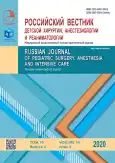Specific features of the adhesion process of the abdominal cavity in children with different degrees of connective tissue dysplasia
- 作者: Minaev S.V.1, Timofeev S.I.2, Grigorova A.N.1, Vladimirova O.V.1, Pashneva E.I.1, Kolesnikov E.G.3
-
隶属关系:
- Stavropol State Medical University
- Magadan Regional Children’s Hospital
- Kuban State Medical University
- 期: 卷 10, 编号 4 (2020)
- 页面: 381-389
- 栏目: Original Study Articles
- URL: https://ogarev-online.ru/2219-4061/article/view/122935
- DOI: https://doi.org/10.17816/psaic705
- ID: 122935
如何引用文章
全文:
详细
Aim. To assess adhesions of the abdominal cavity in children with varying degrees of connective tissue dysplasia (CTD) severity.
Methods. A total of 91 children with average age of 10.6 ± 1.4 years were observed from 2005 to 2019. Composed of 53 boys (58.2%) and 38 girls (41.8%). Patients were divided into two groups: group 1 (69 children without CTD) and group 2 (22 children with CTD). Clinical data and screening cards were used to diagnose DST. All patients underwent an assessment for the clinical course, a macroscopic visual assessment adhesive process severity in the abdominal cavity according to three different scales (Nair, F. Coccolini, N.I. Ayushinova). Immunohistochemistry was performed against collagen I, III, IV type, Laminin γ1, angiogenesis factors, transforming growth factor beta (TGF-β), and Fibroblast Growth Factor Receptor 1 (FGFR1). A semi-quantitative counting method was used to record the relative number of immunopositive structures. Statistical analysis was carried out by methods of variation statistics using the Chi-square test and Mann–Whitney U-tests, as well as the Spearman rank correlation method for the reliability of differences between groups.
Results. In the adhesive process visualization, the N.I. Ayushinov scale was revealed to be the most informative, showing the average score of 7 ± 0.8 points in group 2 and 14 ± 1.2 in group 1 (rs < 0.35; p < 0.05). In group 2, the adhesive material showed no (56%) or chaotic fragments (44%) of type I collagen, and the ratio of type I to type III collagen is 2.7: 5.1. In group 1, the ratio of type I to type III collagen is 5.9:1.8. The ratio of collagen IV to type I is 6.5: 2.9. Both groups have a moderate (++) amount of TGF-β. TGF-β is positive with macrophages. FGFR1 was found in the control group (++++). A positive response was seen in fibroblasts and macrophages (U = 79.00; p = 0.006). Statistically significant analyzes of vascular endothelial growth factor in compared groups (rs = 0.632, p < 0.001) had a positive correlation..
Conclusion. Thus, the study showed features of clinical course and morphological changes during the development of adhesions in the abdominal cavity in children with varying degrees of severity of CTD. Data obtained dictate the need for an individual approach in predicting adhesive disease, as well as targeted preventive care.
作者简介
Sergey Minaev
Stavropol State Medical University
Email: sminaev@yandex.ru
Dr. Sci. (Med.), Professor, Head of the Department of Pediatric Surgery with the course DPO
俄罗斯联邦, StavropolSergey Timofeev
Magadan Regional Children’s Hospital
Email: alina.mashchenko@mail.ru
Cand. Sci. (Med.), Head of the department of pediatric surgery
俄罗斯联邦, MagadanAlina Grigorova
Stavropol State Medical University
编辑信件的主要联系方式.
Email: alina.mashchenko@mail.ru
Cand. Sci. (Med.), Associate Professor of the Department of Pediatric Surgery, assistant Department of Histology
俄罗斯联邦, StavropolOksana Vladimirova
Stavropol State Medical University
Email: alina.mashchenko@mail.ru
Cand. Sci. (Med.), Associate Professor of the Department of Pediatric Surgery with DPO Course
俄罗斯联邦, StavropolElena Pashneva
Stavropol State Medical University
Email: alina.mashchenko@mail.ru
Cand. Sci. (Med.), Associate Professor of the Department of Histology
俄罗斯联邦, StavropolEvgeniy Kolesnikov
Kuban State Medical University
Email: alina.mashchenko@mail.ru
Cand. Sci. (Med.), Assistant of the Department of surgical diseases in children
俄罗斯联邦, Krasnodar补充文件






